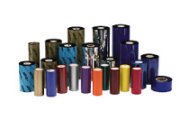



Guide to
Media and Supplies 
Data
ID Systems offers a full range of labels, tags, and ribbons. Click here for answers to frequently asked questions about bar
code label supplies. Click here to find out how to select
labels, tags and ribbons. Follow this link for information on how to select the right bar code
solution for you.
Label
Printer Supplies 
Direct
Thermal Labels and Tags
- Face
materials that are used with direct thermal printers have
a special coating that, over time, will darken if the
material is exposed to UV or sunlight.
- The image is
created by a chemical reaction in the coating which is
brought on by the heat generated from the printhead
coming in contact with the substrate.
- Thermal
labels come in base weights from 15-50 lbs. (6.8-22.7
kg.) and 40-120 lbs. (18.2-54.6 kg.) for tags. These
materials generally have top coating that protects the
materials from water, chemicals and ultraviolet light.
- Some grades
of thermal tags and labels are specifically designed to
be read by scanners that read in infrared light range.
- The advantage
of direct thermal label materials and thermal label
printing is high quality printing at lower cost than
thermal transfer materials (including ribbons).
- Disadvantage
of direct thermal label materials is short label life
especially when exposed to sun light, ultraviolet light,
or heat as well as the limited selection of substrate
when compared to thermal transfer substrates. Also, the
printheads tend to wear fast because of the contact with
the rough surfaces of the thermal papers and tag
materials.

Thermal
Transfer Labels and Tags
Thermal transfer
substrates do not require top coating for the image to be
transferred from the ribbon onto the substrate.
Thermal transfer
substrates are available with some of the following face sheets:
- Uncoated
thermal transfer paper
- Clay coated
thermal transfer paper
- High gloss
coated paper
- Coated Tyvek
(synthetic material)
- Kimdura
(synthetic vinyl)
Thermal transfer
substrates are available in the following face sheets:
- Polyolefin
film
- Top coated
and non-top coated polyesters
- Gloss coated
mylar
- Polypropylene
- Plyethylene
The image is
created when the printhead makes contact with a thermal transfer
ribbon and releases its pigmenting materials above a certain
threshold temperature.
The ribbon is
in physical contact with the substrate, resulting in a stable
high quality image unaffected by temperature up to 250°F
(121 °C) or exposure to ultraviolet light.
The advantages
of thermal transfer printing are the variety of label
materials that can be printed on, the quality and stability
of the printed image both for indoor and outdoor
applications, and longer printhead life because the thermal
transfer ribbon provides a buffer between the label and the
printhead.
Thermal
Transfer Ribbons
Data ID Systems
provides three basic formulas of thermal transfer ribbons, wax,
wax/resin and premium resin. Listed below is an explanation of
each ribbon type and where the ribbon can be used.
Wax
Ribbons
- For normal
and high speed 4" (102 mm) to 10" (254mm) per
second print speed applications
- Good edge
definition
- Good quality
rotated bar codes
- Good abrasion
resistance
- Heat
resistance of printed image to 100 °F (38 °C)
- Good static
resistance
- Low price
Recommended
applications and uses
- Coated and
uncoated labels and tags
- All general
purpose labeling
- Shipping
labels
- Carton
labeling
- Address
labels
- Retail tags
and labels
- Print and
apply applications
- Small
character and graphics labels
Wax/Resin
Ribbons
- For normal
and high speed printing up to 10" (254mm) per second
- Excellent
edge definition
- Good quality
rotated bar codes
- High abrasion
resistance
- Solvent
resistance to petrochemicals and isopropyl alcohol
- Heat
resistance of printed image to 200 °F (100 °C)
Recommended
applications and use
- High gloss
labels, coated labels and tags, and synthetic labels and
tags
- High speed
print and apply applications
- Shelf and bin
labeling, materials management labeling, drum labeling,
parts marking labeling
Polyester
Resin Ribbons
- Super high
gloss paper labels and synthetic labels (i.e. polyester,
kaplon, polyolefin, vinyl, mylar)
- Used in
extreme environmental applications such as hazardous drum
labeling
- Used in
printed circuit board applications, rating plate labels,
engine component labels, labels requiring long life (5-8
years) and all types of outdoor labeling that require
durability.
- Frequently
Asked Questions
-
- Label, Tags and Ribbons
-
- Q.
What types of ribbon are available for thermal printing?
- A.
Wax, Wax/Resin, Resin
-
- Q.
Are color ribbons available for thermal printing?
- A.
Yes, red, green, blue, yellow and some process colors.
-
- Q.
What ribbon is used on paper and tag stocks?
- A.
General purpose wax ribbon will give you the best print
quality and the most scratch resistance.
-
- Q.
On light synthetics what ribbon can we use?
- A.
General purpose resin can be used to get the best print
quality and the most scratch resistance.
-
- Q.
When printing polyester labels what ribbon can I use?
- A.
Poly resin ribbons must be used when printing on any
shiny vinyl thermal stock.
-
- Q.
Why is direct thermal used more than thermal transfer?
- A.
There is no ribbon is required for this printing process
and the cost of each printed label is lower.
-
- Q.
Can thermal transfer be printed on any printer?
- A.
No. The printer must be capable of using a ribbon to
print.
-
- Q.
Can I print on labels that have my logo or other
printing?
- A.
Yes, you can print on labels that have been pre-printed
on a press, as long as there is no printing in the way of
the sensor.
-
- Q.
What label and ribbon do I use when I need to withstand
harsh environment chemicals, such as gasoline, alcohol,
UV rays?
- A.
For such environments, a polyester label and polyester
resin ribbon must be used. A polyester label is made up
of very strong vinyl, and if the ribbon has a high resin
content, you will produce a very durable image, with up
to a 5 year outdoor life.
-
- Q.
What sizes of ribbon available?
- A.
Ribbons are available from 1.5" up to 8.66" (38
to 220 mm) and from 91 meters 600 meters long. The size
of the ribbon will depend on the type of printer you are
using.
-
- Q.
What sizes of tags and labels are available?
- A.
Tags and labels are available from 1” to 8.5”
(25 to 216 mm) wide and from 3/8” to 11” (9 to
279 mm) long.
Bar Codes
- Q.What
do I need to know about bar codes?
- A.
Listed below are characteristics that most bar codes
have in common:
-
- Bars and
Spaces
- Each symbol has a defined pattern of bars and spaces
which can be read or scanned by a bar code reader. The
width of both bars and spaces vary and allow the
representation of different characters. The height of the
bars has interpretive information, yet provides data
redundancy so that the scanner is not limited to a single
scan path.
-
- Character Set - Each bar code
symbology has its own defined character set. In some
cases, these sets are alphanumeric with additional
special characters, while other symbologies only allow
for the encodation of the digits 0 through 9.
-
- Human
Readable Information - The information encoded in a bar code may
be represented in human-readable form below the printed
bar code symbol. This human-readable representation is
optional with some bar codes while mandatory with others.
-
- Fixed vs.
Variable Length - Some bar code symbologies vary in length,
contingent upon the amount of information which needs to
be represented. Other symbologies have a fixed length and
always contain the same amount of encoded information.
-
- “X”
Dimension - Each bar code symbol has a defined
“X” Dimension, or narrow bar. This bar is
measured in thousandths of an inch (or “mils”)
and directly affect the physical size of bar code.
-
- Modular vs.
Binary
- With a modular bar code information is encoded using
bars and spaces which vary from one to four.
- Copyright
©1997-2011 Data Identification Systems All Rights
Reserved





